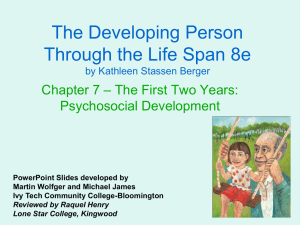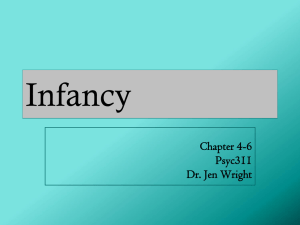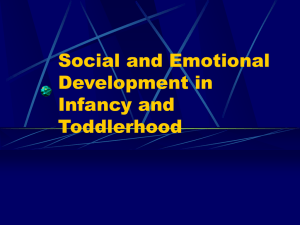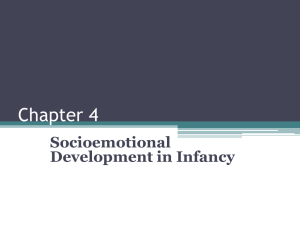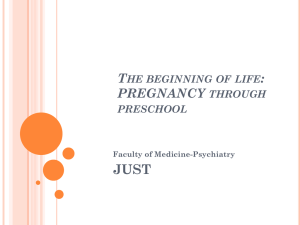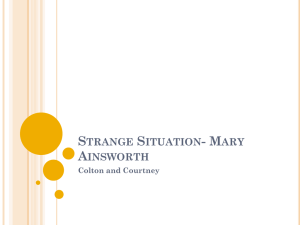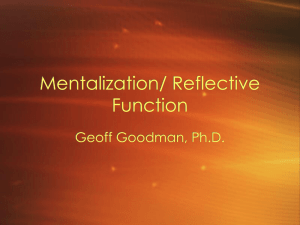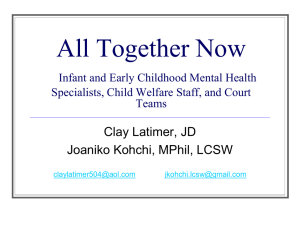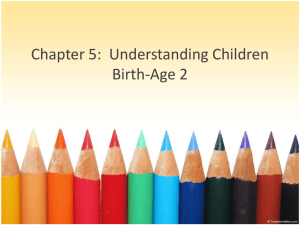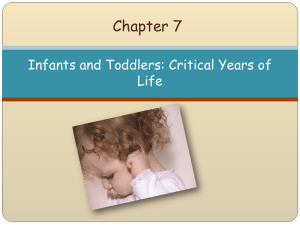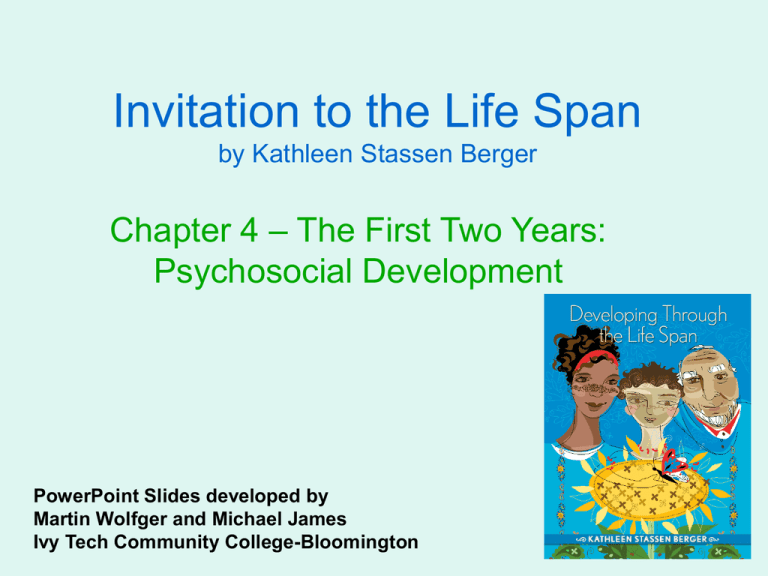
Invitation to the Life Span
by Kathleen Stassen Berger
Chapter 4 – The First Two Years:
Psychosocial Development
PowerPoint Slides developed by
Martin Wolfger and Michael James
Ivy Tech Community College-Bloomington
Emotional Development
Infants’ Emotions
• Smiling and Laughing
– Social smile (6 weeks): Evoked by viewing human faces
– Laughter (3 to 4 months): Often associated with curiosity
• Anger
– First expressions at around 6 month
– Healthy response to frustration
• Sadness
– Indicates withdrawal and is accompanied by increased
production of cortisol
– Stressful experience for infants
Emotional Development
• Fear: Emerges at about 9 months in
response to people, things, or situations
• Stranger wariness:
– Infant no longer smiles at any friendly face
but cries or looks frightened when an
unfamiliar person moves too close
• Separation anxiety:
– Tears, dismay, or anger when a familiar
caregiver leaves.
– If it remains strong after age 3, it may be
considered an emotional disorder.
Emotional Development
Toddlers’ Emotions
• Anger and fear become less frequent and more focused
• Laughing and crying become louder and more
discriminating
• New emotions:
–
–
–
–
Pride
Shame
Embarrassment
Guilt
• Require an awareness of other people
• Emerge from family interactions, influenced by the
culture
Emotional Development
• Self-awareness
– A person’s realization that he or she is a distinct
individual whose body, mind, and actions are
separate from those of other people.
• First 4 months: Infants have no sense of self and
may see themselves as part of their mothers.
• 5 months: Infants begin to develop an
awareness of themselves as separate from their
mothers.
• 15-18 months: Emergence of the Me-self
– Sense of self as the “object of one’s knowledge”
Emotional Development
Mirror Recognition
• Classic experiment (M. Lewis &
Brooks, 1978)
– Babies aged 9–24 months looked
into a mirror after a dot of rouge
had been put on their noses.
– None of the babies younger than
12 months old reacted as if they
knew the mark was on them.
– 15- to 24-month-olds: Showed
self-awareness by touching their
own noses with curiosity.
Emotional Development
Brain Maturation and the Emotions
• Synesthesia
– The stimulation of one sensory stimulus to the brain
(sound, sight, touch, taste, or smell) by another.
– Common in infants because boundaries between
sensory parts of the cortex are less distinct.
• Cross-modal perception
– Infant associates textures with vision, sounds with
smells, own body with the bodies of others
– Basis for early social understanding
• Synesthesia of emotions
– Infant’s cry can be triggered by pain, fear, tiredness, or
excitement; laughter can turn to tears.
– Infants’ emotions are difficult to predict because of the
way their brains are activated.
Social Impulses
• Emotional Self-regulation
– Directly connected to maturation of the anterior
cingulate gyrus
• Particular people begin to arouse specific
emotions
– Toddlers get angry when a teasing older sibling
approaches them or react with fear when entering the
doctor’s office.
– Memory triggers specific emotions based on previous
experiences.
Stress
• Hypothalamus
– Regulates various bodily functions and hormone production
– May grow more slowly in stressed than in nonstressed
infants
• Abuse (form of chronic stress)
– Potential long-term effects on a child’s emotional
development
– High levels of stress hormones indicative of emotional
impairment
– Excessive stress in infants must be prevented
• Stress can be avoided by:
– providing new mothers with help and emotional support
– involving new fathers in the care of the infant
– strengthening the relationship between mother and father
Theories of Infant Psychosocial
Development
PSYCHOANALYTIC THEORY
FREUD: THE ORAL AND ANAL STAGES
• Oral stage (first year): The mouth is the young infant’s primary
source of gratification
• Anal stage (second year): Infant’s main pleasure comes from the
anus (e.g. sensual pleasure of bowel movements and the
psychological pleasure of controlling them)
Potential conflicts:
• Oral fixation: If a mother frustrates her infant’s urge to suck, the child
may become an adult who is stuck (fixated) at the oral stage (e.g.
eats, drinks, chews, bites, or talks excessively)
• Anal personality: Overly strict or premature toilet training may result
in an adult with an unusually strong need for control, regularity and
cleanliness
Theories of Infant Psychosocial
Development
ERIKSON: TRUST AND AUTONOMY
• Trust versus Mistrust
– Infants learn basic trust if the world is a secure place
where their basic needs are met
• Autonomy versus Shame and Doubt
– Toddlers either succeed or fail in gaining a sense of
self-rule over their actions and their bodies
• Early problems can create an adult who is
suspicious and pessimistic (mistrusting) or who
is easily shamed (insufficient autonomy)
Theories of Infant Psychosocial
Development
BEHAVIORISM
• Parents mold an infant’s emotions and
personality through reinforcement and
punishment
• Social learning
– The acquisition of behavior patterns by observing the
behavior of others
– Demonstrated in the classic Bobo Doll study by Albert
Bandura
Theories of Infant Psychosocial
Development
COGNITIVE THEORY
• Working model: Set of assumptions that the
individual uses to organize perceptions and
experiences
– A person might assume that other people are
trustworthy and be surprised by evidence that this
working model of human behavior is erroneous.
– The child’s interpretation of early experiences is more
important than the experiences themselves.
– New working models can be developed based on new
experiences or reinterpretation of previous
experiences.
Theories of Infant Psychosocial
Development
ETHNOTHEORY
• A theory that underlies the values and practices
of a culture but is not usually apparent to the
people within the culture.
• Example:
– Culture’s ethnotheory includes the belief in
reincarnation
– Children are not expected to show respect for adults,
but adults must show respect for their reborn
ancestors indulgent child-rearing
– Perceived as extremely lenient by Western cultures
Theories of Infant Psychosocial
Development
SYSTEMS THEORY
• Epigenetic approach to development,
using all five characteristics of the lifespan perspective (multidirectional,
multicontextual, multicultural, multi
disciplinary, and plastic)
– Systems theory is especially insightful in
interpreting temperament.
Theories of Infant Psychosocial
Development
• Temperament
– Inborn differences between one person and
another in emotions, activity, and selfregulation
– Temperament is epigenetic, originating in the
genes but affected by child-rearing practices
• New York Longitudinal Study (NYLS)
– Started in the 1960s
– Found 4 categories of temperament
Theories of Infant Psychosocial
Development
• Easy (40%)
• Difficult (10%)
• Slow to warm up (15%)
• Hard to classify (35%)
Additional findings:
• Temperament often changes in the early weeks
but is increasingly stable by age 3
• Extreme temperaments at age 3 tend to carry
over to adolescence and young adulthood
• Parenting practices are crucial, temperament
can change or be changed
Theories of Infant Psychosocial
Development
•
The Big Five (acronym OCEAN)
– Five basic clusters of personality traits that remain
quite stable throughout life
– Found in many cultures and among people of all
ages
1. Openness: imaginative, curious, welcoming new
experiences
2. Conscientiousness: organized, deliberate, conforming
3. Extroversion: outgoing, assertive, active
4. Agreeableness: kind, helpful, easygoing
5. Neuroticism: anxious, moody, self-critical
Theories of Infant Psychosocial
Development
• Longitudinal study of infant temperament (Fox et al.,
2001): Grouped 4-month-olds into three distinct types
based on responses to fearful stimulation
– Positive (exuberant)
– Negative
– Inhibited (fearful)
• Less than half altered their responses as they grew older
– Fearful infants were most likely to change
– Exuberant infants were least likely to change
– Maturation and child rearing has effect on inborn temperament
Theories of Infant Psychosocial
Development
The Effects of Parenting
• Proximal parenting
– Caregiving practices that involve being
physically close to the baby, with frequent
holding and touching
• Distal parenting
– Caregiving practices that involve remaining
distant from the baby, providing toys, food,
and face-to-face communication with minimal
holding and touching
The Effects of Parenting
Goodness of Fit
• A similarity of temperament and values that
produces a smooth interaction between an
individual and his or her social context, including
family, school, and community
• With a good fit
– parents of difficult babies build a close relationship
– parents of exuberant, curious infants learn to protect
them from harm
– parents of slow-to-warm-up toddlers give them time to
adjust
Synchrony
• A coordinated, rapid, and smooth
exchange of responses between a
caregiver and an infant
• Synchrony in the first few months
– Becomes more frequent and more
elaborate
– Helps infants learn to read others’
emotions and to develop the skills of
social interaction
– Synchrony usually begins with
parents imitating infants
Is Synchrony Needed for Normal
Development?
• Experiments using the still-face technique
– An experimental practice in which an adult keeps his
or her face unmoving and expressionless in face-toface interaction with an infant
– Babies are very upset by the still face and show signs
of stress
• Conclusions:
– A parent’s responsiveness to an infant aids
psychological and biological development
– Infants’ brains need social interaction to develop to
their fullest
Attachment
• Attachment is a lasting emotional bond
that one person has with another.
– Attachments begin to form in early infancy
and influence a person’s close relationships
throughout life
Attachment
Attachment Types
1.
2.
3.
4.
Secure attachment: An infant obtains both comfort
and confidence from the presence of his or her
caregiver.
Insecure-avoidant attachment: An infant avoids
connection with the caregiver, as when the infant
seems not to care about the caregiver’s presence,
departure, or return.
Insecure-resistant/ambivalent attachment: An
infant’s anxiety and uncertainty are evident, as when
the infant becomes very upset at separation from the
caregiver and both resists and seeks contact on
reunion.
Disorganized attachment: A type of attachment that
is marked by an infant’s inconsistent reactions to the
caregiver’s departure and return.
Attachment Types
Measuring Attachment
• Strange Situation
– A laboratory procedure for measuring attachment by
evoking infants’ reactions to the stress of various
adults’ comings and goings in an unfamiliar playroom.
• Key behaviors to observe:
– Exploration of the toys. A secure toddler plays happily.
– Reaction to the caregiver’s departure. A secure
toddler misses the caregiver.
– Reaction to the caregiver’s return. A secure toddler
welcomes the caregiver’s reappearance.
Measuring Attachment
Measuring Attachment
Social Referencing
• Social referencing
– Seeking information about how to
react to an unfamiliar or
ambiguous object or event by
observing someone else’s
expressions and reactions. That
other person becomes a social
reference.
• Mothers use a variety of
expressions, vocalizations, and
gestures to convey social
information to their infants.
Fathers as Social Partners
• Fathers usually spend less time with
infants than mothers do and are less
involved parents
• Reasons:
– Fathers’ own ideas of appropriate
male behavior
– Mothers often limit fathers’
interactions with their children
• Quality of marital relationship is best
predictor
– Happier husbands tend to be
more involved fathers
Comparing Mothers and Fathers
• Selected research findings:
– Teenagers are less likely to lash out at friends and authorities if
they experienced a warm, responsive relationship with their
fathers as infants (Trautmann-Villalba et al., 2006).
– Infants may be equally securely attached to both parents, more
attached to their mothers, or more attached to their fathers
(Belsky et al., 2006).
– Close father–infant relationships can teach infants (especially
boys) appropriate expressions of emotion (Boyce et al., 2006).
– Close relationships with their infants reduce fathers’ risk of
depression (Borke et al., 2007; Bronte-Tinkew et al., 2007).
– Mothers tend to engage in more caregiving and comforting, and
fathers tend to engage in more high-intensity play (Kochanska et
al., 2008).
– When toddlers are about to explore, they often seek their father’s
approval, expecting fun from their fathers and comfort from their
mothers (Lamb, 2000).
Infant Day Care
• Family day care
– Child care that includes several children of various
ages and usually occurs in the home of a woman who
is paid to provide it.
• Center day care
– Child care that occurs in a place especially designed
for the purpose, where several paid adults care for
many children.
– Usually the children are grouped by age, the day-care
center is licensed, and providers are trained and
certified in child development.
Infant Day Care
The Effects of Infant Day Care
• The impact of nonmaternal care depends on
many factors.
• Psychosocial characteristics, including secure
attachment, are influenced more by the mother’s
warmth than by the number of hours spent in
nonmaternal care.
• Quality of care is crucial, no matter who provides
that care.
The Effects of Infant Day Care


